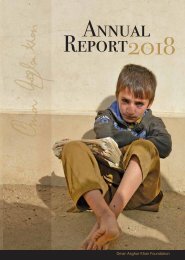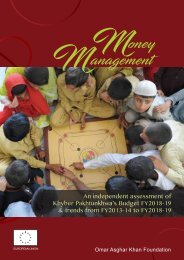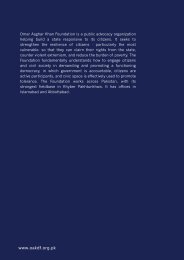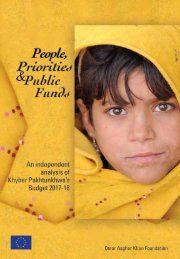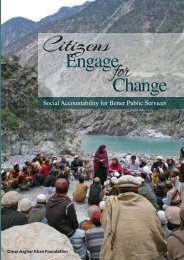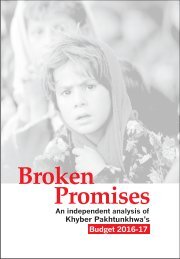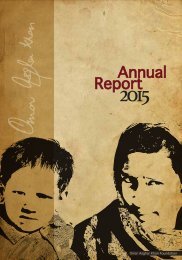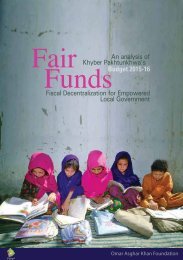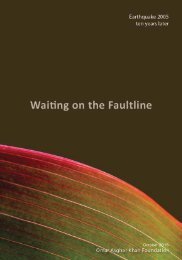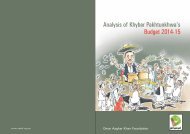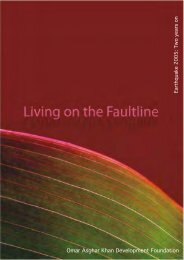Union Council Rehabilitation Plan
Create successful ePaper yourself
Turn your PDF publications into a flip-book with our unique Google optimized e-Paper software.
URAP<br />
<strong>Union</strong> council rehabilitation <strong>Plan</strong>
Urap- Pattan Kalan, District Abbottabad<br />
Objectives<br />
The objective of the Urap was for the people of a particular union council to analyze and assess<br />
their existing situation. On the basis, of this analysis of this assessment and through a participatory<br />
process they worked together to prioritize their needs.<br />
The process was meant to bring people of different villages together to collectively share and decide<br />
how best the rehabilitation and development process should be carried out within heir villages<br />
and at the level of the union council so that the resources developed created maximum benefit for<br />
the people of the <strong>Union</strong> council<br />
The Urap is a living document and a shared vision of how the people of the U.C. would like to see<br />
the government commit funding for their areas. This document developed collectively, outlines the<br />
minimum necessities required to create an environment where access to services, health and education<br />
and the provision of infrastructure is within acceptable limits. It is hoped, that government and<br />
nongovernmental funding will respond to the needs that have been ascertained by the people<br />
through a process of analysis and negotiation.<br />
Omar Asghar khan Development Foundation
Urap- Pattan Kalan, District Abbottabad<br />
Choice of <strong>Union</strong> council<br />
On 8th October 2005 a devastating earthquake hit the north of Pakistan and Azad Jammu and<br />
Kasmir causing wide spread destruction and leaving more than 80,000 people dead. Abbottabad<br />
district in the NWFP was amongst the areas that faced the brunt of this devastation. Amongst the<br />
51 union councils of the district 7 were very badly effected. The foundation when deciding on the<br />
Pattan Kalan is one of the 51 <strong>Union</strong> <strong>Council</strong>s of Abbottabad District in the North-West Frontier Province<br />
of Pakistan. Pattan Kalan is located in the eastern edge of Abbottabad district where it forms part of the<br />
North-West Frontier's border with Muzaffarabad District, Kashmir. It also borders the following <strong>Union</strong><br />
<strong>Council</strong>s within Abbottabad district, Kukmang and Boi to the north, Kuthwal to the west, Beerangali and<br />
Nambal to the south. The <strong>Union</strong> <strong>Council</strong>, with a population of 16116, is subdivided into the following areas:<br />
Bandi Sararha, Banota, Chamiali, Khokhriala, Larri, Sialkot, Maseena Kalan and Pattan Kalan<br />
choice of union council for the Urap decided to choose one of these. The following considerations<br />
shaped its decision to choose Pattan Kalan<br />
Amongst the UCs under consideration, Pattan Kalan consisted of villages that did not have strong<br />
local organizations as compared to the others. The foundation felt that this intervention would help<br />
improve its links within the UC and give impetus to its efforts of helping the people organize at the<br />
village level. It was a UC the foundation was least familiar with and as such would help us ascertain<br />
whether it was possible to conduct such a process without effective partners in each of the 24<br />
villages.<br />
The challenges in this UC for implementing this program were greater. It was newly formed by the<br />
amalgamation of two union councils hence the level of social cohesion was questionable. This<br />
would bring to the fore issues at the planning and negotiating stage and as such would be a good<br />
learning experience.<br />
The Urap process was broadly divided into the following steps:<br />
Stage 1<br />
• Selection of <strong>Union</strong> council<br />
• Selection of villages for Vraps: This was governed by the existence of effective partner organisations<br />
and by their geographic location within the union council.<br />
• Developing a framework for the Vraps: This was done by the foundation through a workshop<br />
attended by all staff. It comprised of sections that related to the situation before the<br />
earthquake, the seffect of the earthquake on existing facilities within the village and the family<br />
itself. It’s effect on people, their sources of livelihood and the losses they had suffered.<br />
They also through this participatory process analysed their situation and stated their priority<br />
needs for the rehabilitation process<br />
• Training of activists for conducting Vraps : Activists from different areas participated in this<br />
2-day training conducted by the foundation. It outlined PRA methodology and taught the<br />
participants how to use various PRA tools for analysis and reflection<br />
Omar Asghar khan Development Foundation
• Conducting Vrap: the activists implemented The Vraps with assistance given by foundation<br />
staff. On average it took 15 days to conduct the process within each village. The process was<br />
carried out separately with men and women.<br />
Stage 2<br />
• Analyzing and synthesizing information gathered through the Vraps. This was done by the<br />
foundation.<br />
• A questionnaire for the survey: This was developed by the foundation and was based on the<br />
Vraps.<br />
• This involved developing a social map of the union council. It helped define how people see their<br />
union council and how they identify are village. It also helped the foundation staff pinpoint<br />
where gaps in representation were present. The villages as seen by the people of the union council<br />
normally vary from those as shown on government records. In this case, the people identified<br />
24 villages by further subdividing the 8 revenue villages.<br />
• The gaps in representation were filled, by asking activists to contact those villages not represented<br />
and a follow up meeting held to ensure full participation of the union council in the Urap process.<br />
• Training of activists and P.O. representatives from the <strong>Union</strong> <strong>Council</strong> was conducted to develop a<br />
methodology for the survey.<br />
• Local activists, urban youth and the foundation staff collectively carried out the survey in all 24<br />
villages. This survey was conducted by taking a sample of 10% of all households with equal representation<br />
of male and females.<br />
• The survey was based on the vrap framework and helps ascertain the conditions before the earthquake,<br />
the facilities available and the destruction caused. It also asked people to prioritize their<br />
needs at the village level.<br />
• The results of the survey analyzed and tabulated. The priorities given numerical values in order<br />
of priority and village priorities identified through this exercise.<br />
• The social map prepared initially was up-graded through information gathered in surveys and<br />
consultation with local government officials.<br />
“This is the first time we have seen a map of our union council showing our villages”<br />
A participant at the U.C. meeting<br />
The foundation staff through extensive research gathered data on government allocations for work in various<br />
sectors that had either begun or earmarked through the issuance of PC-1’s. This was verified on ground as far<br />
as it was possible.<br />
The information that evolved could then be summarized into 3 categories:<br />
1. Government allocations<br />
2. Village level priorities<br />
3. Existing facilities<br />
Urap- Pattan Kalan, District Abbottabad<br />
Omar Asghar khan Development Foundation
Urap- Pattan Kalan, District Abbottabad<br />
<strong>Union</strong> <strong>Council</strong> Meeting<br />
A grand meeting of the activists representing all the villages of the <strong>Union</strong> council was held on 25th,<br />
26th and 30th and 31 st of July 2008 at the foundation office in Abbottabad. This was conducted in<br />
two 2-day sessions. The process was as follows:A map developed from the social map was presented<br />
for approval and with a few minor changes was adopted as a true representation of the location<br />
of roads and villages.<br />
A number of large maps were printed and displayed. Village representatives were each given a<br />
folder containing a list of priorities as developed through the vraps and the surveys. These were<br />
also displayed in full view of all participants. They were given an opportunity to go through all<br />
these priorities.One by one each exercise was conducted through the use of maps and symbols<br />
which were displayed. Different colored pins, ribbons etc symbolized various facilities.<br />
Exercise 1<br />
Representative of each village were asked to come to the<br />
map, locate their village and place symbols of the top 3<br />
priorities of the village that were ascertained as a result of<br />
the Vrap and surveys conducted.<br />
Exercise 2<br />
After all the villages had placed their priorities on the map, they were asked to make groups, each<br />
consisting of people from the same village and review their priorities and decide which of these<br />
were solely to benefit the village and which of these could either impact the UC or a group of villages.<br />
They were also asked to pinpoint facilities which were linked or dependent on other villages.<br />
After reaching consensus within the groups they were asked to transfer those symbols from the<br />
map representing village priorities to a new one placed alongside it that represented UC priorities.<br />
Exercise 3<br />
Village reps were then asked to work on a third map. This<br />
exercise was meant to establish linkages and inter village<br />
dependencies. Each village came and connected ribbons<br />
between their village and others. The links symbolized<br />
access to facilities, social contacts and relationships. It was<br />
interesting to see that the village with greater facilities had<br />
a greater sphere of influence. This networking diagram<br />
and people’s responses gave interesting insights into the<br />
political dynamics that prevail.<br />
Networking diagram<br />
Omar Asghar khan Development Foundation
Urap- Pattan Kalan, District Abbottabad<br />
Exercise 4<br />
The networking diagram was used to make clusters. There were some adjustments made however<br />
as the links displayed were in some cases not based on<br />
choice. These groups were asked to review their priorities<br />
and decide if a facility could be shared rather than be present<br />
in each village e.g. a high school would need a certain minimum<br />
number of students. They were also asked to see if a<br />
water source could be shared, a road designed so that it was<br />
of greater benefit and more efficient. In essence, review and<br />
adjust these priorities so that maximum benefit could<br />
be derived through minimum investment. It was thus a<br />
process of negotiation and involved thinking beyond the village<br />
<br />
Negotiating and proposing<br />
Exercise 5<br />
Each cluster made its suggestions. These adjustments were<br />
made to the U.C. plan and other villages were also allowed<br />
to respond. It was seen that within the clusters gave up certain<br />
facilities and accepted their location in other villages<br />
with a view to sharing them specially with respect to schools<br />
and health facilities. In the plenary hard negotiation were<br />
also seen in the following circumstances:<br />
If a proposal was unfeasible<br />
If a location was only benefiting a particular village<br />
If a scheme was deemed to be too expensive<br />
Exercise 6<br />
The identified works were designed and costed. The activists<br />
and the foundations engineers together worked out the cost<br />
of infrastructure schemes. Facilities such as schools and<br />
health facilities were costed through available government<br />
tenders.<br />
The costs were tabulated and a cost for the overall URAP<br />
were finallisedIn the end the final URAP was reviewed and<br />
final approval given. Each map was photographed for record<br />
purposes.These maps were then reproduced to reflect people’s<br />
priorities as finalized in the workshop, existing facilities<br />
and government allocations as reflected in the PCI. These maps Costing and designing<br />
were professionally drawn, printed and taken to the people<br />
of the union council This was achieved through a series of corner meetings organized by activists.<br />
Omar Asghar khan Development Foundation
Urap- Pattan Kalan, District Abbottabad<br />
The people’s assembly<br />
As decided in the workshop 2 people’s assemblies were planned to follow the corner meetings.<br />
The issues discussed at the people’s assembly were in the following sequence. It was an interactive<br />
process and people were presented the work carried out by the activists and their reactions solicited<br />
through the following steps<br />
What is a URAP ?<br />
A plan developed in consultation with the people. It must reflect people’s priorities and how they<br />
would wish to see their UC develop over a fixed timeframe.<br />
Why a need for it?<br />
The following points were raised to identify the importance of the URAP<br />
• Ascertaining the needs of the UC as seen by the people.<br />
• Combined ownership of a development plan for the UC<br />
• Basis for an advocacy campaign<br />
• Tool for negotiating with various tiers of government.<br />
• Information basis for public representatives and various governmental and non-governmental<br />
agencies.<br />
An introduction to the process<br />
The activists informed the assembly how the URAP was developed. The steps they identified included<br />
the following:<br />
• Vraps<br />
• Surveys<br />
• Ascertaining village priorities<br />
• UC priorities<br />
• Synthesising peoples priorities<br />
• Analysing needs and making choices<br />
• Presentation and validation<br />
Omar Asghar khan Development Foundation
Urap- Pattan Kalan, District Abbottabad<br />
Presentation of the process<br />
Activists Identified priorities at village level and informed others how these would benefit the other<br />
villages within the UC Those that were negotiated were also identified and the shifting of a certain<br />
priority and the reasons behind this were shared with the participants. This process focused on<br />
people’s priorities and mainly dealt with the following sectors<br />
Schools<br />
Health facilities<br />
Roads<br />
Water<br />
Others<br />
Government Allocations.<br />
The allocations made for projects were presented by the foundation staff and those not yet initiated<br />
identified by the people present. These were dealt with sector-wise and the dialogue was based on<br />
the information gathered from government documents and related to government allocations. A<br />
comparison of peoples priorities and government allocations was also presented and the gap in resources<br />
identified.<br />
Methodology to create changes to the URAP<br />
It was decided that if a village wants to make any change in the URAP it shall through a resolution<br />
duly signed by atleast 50% of the households of the village request an amendment. This shall be<br />
brought to the UC meeting to review the proposal and take a decision. A 6 month timeframe was<br />
suggested for review. This meeting will also act as a monitoring meeting of progress of projects.<br />
Omar Asghar khan Development Foundation
Urap- Pattan Kalan, District Abbottabad<br />
Strategy for implementation of the URAP<br />
It was decided that follow-up needs to take place to take this work forward and a joint strategy was<br />
devised. The points that were raised are as follows:<br />
• Strengthen people’s organizations<br />
• To acquaint people with the URAP. Meetings at village level to share the process. To build understanding<br />
and ownership<br />
• Meetings with the provincial and federal government and Perra officials. To seek support and explain<br />
the process. Projects clearly identified and an idea of costs will enable better negotiation<br />
• Presenting the Urap to donor agencies. To seek support and explain the process<br />
• Projects identified that could be built in partnerhip to reduce costs<br />
• Phase-wise development could be developed within a timeframe.<br />
• A campaign to bring attention to the URAP process that will include<br />
• Billboards on the main roads.<br />
• Posters, banners and plans displayed in the villages.<br />
• Articles in newspapers, statements in the press and media attention<br />
• Seminars, etc. to highlight Pattan’s plan and its people’s commitment to see it fulfilled.<br />
<br />
The Final proposal of the <strong>Union</strong> <strong>Council</strong> <strong>Rehabilitation</strong> Action <strong>Plan</strong><br />
Omar Asghar khan Development Foundation




